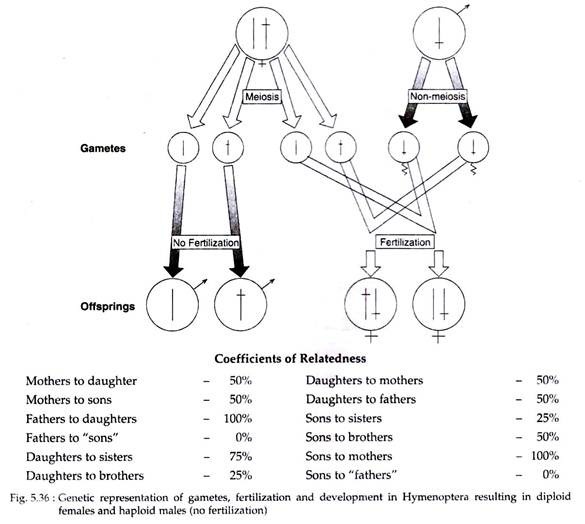In this article we will discuss about the meaning and evolution of altruism among animals.
Meaning of Altruism:
Altruism is defined as doing good to others, such as sharing food, warning others of danger, adopting orphans, defending one’s own colony etc. Though small, there is always a cost involved in altruism. The altruists spend time which could have been used for one’s own work or for other purposes.
In genetic terms it can be said that altruistic behaviour raises the fitness of another individual while lowering one’s own fitness. Let us consider there are two alleles in a population of animals (X and X’). Of the two alleles, X favours the possessor of doing well to another member of a species, by saving it from the clutches of a predator.
X’ possessor favours in not getting involved. In most instances, X’ possessor is going to live longer and also reproduce more than the possessor of X. Therefore, allele X – favouring altruistic behaviour – will decline in the population.
Evolution of Altruism:
ADVERTISEMENTS:
Seemingly altruistic behaviour occurs in many animals including humans. The question intriguing socio-biologists is how altruistic behaviour has evolved.
Researches in the past 20 years have led to three explanations:
Explanation 1:
Selfish Behaviour:
ADVERTISEMENTS:
Selfish behaviour is beneficial to the actor, although others in the group may also benefit. Details about it have been given earlier (page 611).
Explanation 2:
ADVERTISEMENTS:
Kin Selection:
W. D. Hamillon (1963) proposed a mechanism, Kin Selection, for the evolution of altruistic behaviour in spite of where individual fitness was lowered.
Explanation 3:
Eusociality:
The evolution of sterile castes in termites, ants, bees and wasps is probably due to kin selection. Most of the members in the colony show what might be regarded as the ultimate in altruism. These numbers give up individual fitness entirely and devote their efforts to the good of the colony.
How can an individual ant, bee, or wasp worker help transfer traits she possesses to the next generation? This can be best explained through Fig. 5.36. A female individual can either breed and produce offsprings or she can take care of her sisters.
Because of haplodiploidy a female hymenopteran could best evolve by taking care of her sisters with whom she shares 75% of her genes. On the other hand, if she produces offsprings, the offsprings would have only 50% of her genes (Fig. 5.36).
In the social grouping of birds occupying a territory, only one bird lays eggs and only one male fertilizes them. The rest of the birds help feed younger siblings and defend the nest from predators. When either of the dominant male or female dies, their place is taken up by one of the helpers.
ADVERTISEMENTS:
K. Rabenold (1984), working with tropical wrens, found that twosomes almost never managed to raise any young. A male and a female with one helper did no better. A pair with two helpers were able to raise four times as many young as twosomes or trios. Groups of six or eight raised twice as many as the quartets. The important factor in improved nesting success seems to be better defence from predators.
In case of the helper wrens, they can strike off on their own to form pairs, but they prefer to be helpers, wasting their time and energy and exposing themselves to predation for virtually nothing, not even genetically! They, however, are contributing to the success of their brothers and sisters, who share 50% of their genes. Thus, genes preferring helping are being passed along.
Cooperative breeding in most other vertebrates also is the only path to successful reproduction. Predation or other factors make only cooperative efforts successful or because all suitable habitats are already occupied. Thus, helping can also increase the fitness of individuals.
Reciprocal Altruism:
W. D. Hamilton (1963) tackled the question of how altruistic behaviour could evolve among blood relatives. How could any behaviour that was detrimental to the actor, but beneficial to the recipient, be favoured by natural selection? It is obvious that natural selection would reject such actions, favouring those who receive but fail to give.
Robert Trivers (1971) has put forward a “reciprocal altruism” model that provides an initial answer to this riddle by suggesting that altruism can be favoured when altruistic acts are exchanged by individuals. It is just like I will scratch your back if you scratch mine.
